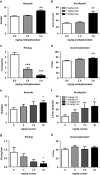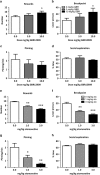Contrasting Roles of Dopamine and Noradrenaline in the Motivational Properties of Social Play Behavior in Rats
- PMID: 26174597
- PMCID: PMC4707831
- DOI: 10.1038/npp.2015.212
Contrasting Roles of Dopamine and Noradrenaline in the Motivational Properties of Social Play Behavior in Rats
Abstract
Social play behavior, abundant in the young of most mammalian species, is thought to be important for social and cognitive development. Social play is highly rewarding, and as such, the expression of social play depends on its pleasurable and motivational properties. Since the motivational properties of social play have only sporadically been investigated, we developed a setup in which rats responded for social play under a progressive ratio schedule of reinforcement. Dopaminergic neurotransmission plays a key role in incentive motivational processes, and both dopamine and noradrenaline have been implicated in the modulation of social play behavior. Therefore, we investigated the role of dopamine and noradrenaline in the motivation for social play. Treatment with the psychostimulant drugs methylphenidate and cocaine increased responding for social play, but suppressed its expression during reinforced play periods. The dopamine reuptake inhibitor GBR-12909 increased responding for social play, but did not affect its expression, whereas the noradrenaline reuptake inhibitor atomoxetine decreased responding for social play as well as its expression. The effects of methylphenidate and cocaine on responding for social play, but not their play-suppressant effects, were blocked by pretreatment with the dopamine receptor antagonist α-flupenthixol. In contrast, pretreatment with the α2-adrenoceptor antagonist RX821002 prevented the play-suppressant effect of methylphenidate, but left its effect on responding for social play unaltered. In sum, the present study introduces a novel method to study the incentive motivational properties of social play behavior in rats. Using this paradigm, we demonstrate dissociable roles for dopamine and noradrenaline in social play behavior: dopamine stimulates the motivation for social play, whereas noradrenaline negatively modulates the motivation for social play behavior and its expression.
Figures





Similar articles
-
The neurobiology of social play and its rewarding value in rats.Neurosci Biobehav Rev. 2016 Nov;70:86-105. doi: 10.1016/j.neubiorev.2016.07.025. Epub 2016 Aug 29. Neurosci Biobehav Rev. 2016. PMID: 27587003 Free PMC article. Review.
-
Amphetamine and cocaine suppress social play behavior in rats through distinct mechanisms.Psychopharmacology (Berl). 2014 Apr;231(8):1503-15. doi: 10.1007/s00213-013-3272-9. Epub 2013 Sep 22. Psychopharmacology (Berl). 2014. PMID: 24057815 Free PMC article.
-
On the central noradrenergic mechanism underlying the social play-suppressant effect of methylphenidate in rats.Behav Brain Res. 2018 Jul 16;347:158-166. doi: 10.1016/j.bbr.2018.03.004. Epub 2018 Mar 8. Behav Brain Res. 2018. PMID: 29526788
-
The role of the nucleus accumbens shell in the mediation of the reinforcing properties of a safety signal in free-operant avoidance: dopamine-dependent inhibitory effects of d-amphetamine.Neuropsychopharmacology. 2014 May;39(6):1420-30. doi: 10.1038/npp.2013.337. Epub 2013 Dec 12. Neuropsychopharmacology. 2014. PMID: 24336447 Free PMC article.
-
Estradiol, dopamine and motivation.Cent Nerv Syst Agents Med Chem. 2014;14(2):83-9. doi: 10.2174/1871524914666141226103135. Cent Nerv Syst Agents Med Chem. 2014. PMID: 25540977 Free PMC article. Review.
Cited by
-
REM Sleep Loss-Induced Elevated Noradrenaline Plays a Significant Role in Neurodegeneration: Synthesis of Findings to Propose a Possible Mechanism of Action from Molecule to Patho-Physiological Changes.Brain Sci. 2023 Dec 21;14(1):8. doi: 10.3390/brainsci14010008. Brain Sci. 2023. PMID: 38275513 Free PMC article. Review.
-
Characterization of Amphetamine, Methylphenidate, Nicotine, and Atomoxetine on Measures of Attention, Impulsive Action, and Motivation in the Rat: Implications for Translational Research.Front Pharmacol. 2020 Apr 24;11:427. doi: 10.3389/fphar.2020.00427. eCollection 2020. Front Pharmacol. 2020. PMID: 32390829 Free PMC article.
-
Noradrenergic modulation of play in Sprague-Dawley and F344 rats.Psychopharmacology (Berl). 2025 May;242(5):955-964. doi: 10.1007/s00213-023-06419-2. Epub 2023 Jul 10. Psychopharmacology (Berl). 2025. PMID: 37428218
-
Noradrenaline effects on social behaviour, intergroup relations, and moral decisions.Neurosci Biobehav Rev. 2016 Jul;66:54-60. doi: 10.1016/j.neubiorev.2016.03.031. Epub 2016 Apr 25. Neurosci Biobehav Rev. 2016. PMID: 27126289 Free PMC article. Review.
-
The neurobiology of social play and its rewarding value in rats.Neurosci Biobehav Rev. 2016 Nov;70:86-105. doi: 10.1016/j.neubiorev.2016.07.025. Epub 2016 Aug 29. Neurosci Biobehav Rev. 2016. PMID: 27587003 Free PMC article. Review.
References
-
- Aston-Jones G, Cohen JD (2005). An integrative theory of locus coeruleus-norepinephrine function: adaptive gain and optimal performance. Annu Rev Neurosci 28: 403–450. - PubMed
Publication types
MeSH terms
Substances
Grants and funding
LinkOut - more resources
Full Text Sources
Other Literature Sources
Molecular Biology Databases

